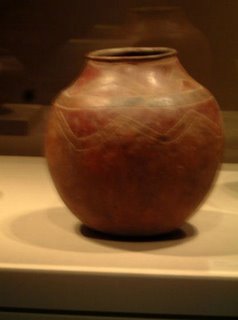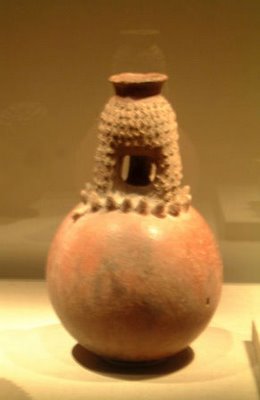Keith Achepohl Collection

Born in 1934, Keith Achepohl is currently the head of the printmaking Dept. at the University of Iowa -- and somewhere along the way he collected a lot of African pottery.

As he tells it, he began his collection while traveling through Africa.
Dealers would pull up their trucks at the markets and he would go through their stuff -- looking for the unusual, the extraordinary. That's the kind of collection it is -- based less on historical authenticity and more on what looks interesting. So the museum's official title of this exhibit, "For Hearth and Altar", is somewhat misleading. It should be called "For fun viewing".

There's a good-natured, swinging goofiness about many of these things -- like those
neighborhood brass bands that proliferate in some not-yet-industrialized countries around the world -- and I can understand why Mr. Archepohl says he sold his collection of contemporary American pottery when he discovered these engaging objects, most (but not all) of which also contemporary, i.e. mid to late 20th Century.

I'd like to put some of the large jars side-by-side with the 16th Century Japanese jars (also in the Art Institute) that are so similar in size/shape/color -- but feel so different -- as they reflect an intellectual choice to be simple/natural that goes back to the Taoist philosphers of the 4th century BCE.
It's also interesting to see Mr. Achepohl's own graphics -- as they reflect the disastrous consequence of academic modernism on the European pictorial tradition: - failing as both design, picture, and engaging expression -- even if pleasant enough for a dentist's waiting room.
I'd also like to note that although the musuem's brochure tells us that these "often surprising ceramic vessels have been created for domestic and ritual uses" -- there's
no documentation to that effect -- and it's quite likely that since most of them are less than 50 years old, many of them were made for the collector's market -- which would, of course, in the twisted art-philosophy of the art museum, disqualify them as art objects worthy of their collection. One may also note that not a single potter is identified by name -- although if it really counted - i.e. -- if name were important to value like it is in the post Renaissance European tradition, inquiries could have been made -- the artists, or at least their children/grandchildren are still living -- and some artists could have been identified. But that would have removed them from their mythic state of anonymity - and probably revealed that the artist did, occasionally, make things for sale to dealers. (who wouldn't jump at the chance of making some money?)
So the contemporary tribal artist is honored as such only as long as he remains
anonymous. Once known -- he's no longer an artist at all -- he's just a manufacturer of trinkets for tourists and street fairs in places like Chicago or Atlanta.


3 Comments:
The Thaw collection (also a "privately-made" collection) of Native American art here in Cooperstown has some wonderful bravura pieces of work sold for the tourist trade--the miniature baskets, intricately woven from grass fine as hair, stick in my mind, but there are pots and dolls and stone carvings of sailors and more. Tourist work is actually an interesting step sideways from inherited, need-based forms, because it allows more "showing off." But it seems that basket makers did sometimes make minute baskets simply to display their skill, even aside from the trade. It seems that the first change the outside world brings is almost always size--to make the thing more portable, packable, and sometimes more a "curio cabinet" miniature.
Of course, there are astonishing feats of beadwork, say, that display a mother's overwhelming pride in a toddler, and had nothing to do with desire for sale.
It would be interesting to know whether these pots could have been identified, or whether it simply wasn't an issue for the collector at that time and place... And the links to tribes might be interesting as well. Two of the pots (in the same picture) look like ritual scarification, and another has a vaguely zigzag, possibly braided look.
I like the "swinging goofiness" description.
Another "interesting step sideways" was taken by the quilting community of Gee's Bend (that I first learned about from some $.39 Postage stamps)
It probably served a tourist trade in the past -- but now it's gotten recognition as high-end art (and just had an exhibit in Indianapolis -- which I almost went to see.
I suppose it takes some special marketing expertise to get into that niche -- and I wish these African potters had that kind of help.
They do seem to have had the "luck" of being lightly kissed by history, and I suppose that helped. Plus a great name. Gee's Bend.
There are quite a few "fair market" catalogues around now; I wonder how much those help. Of course, getting in one of those doesn't leave much room for variation.
I remember those bold stamps... I have a number of family quilts (and handquilting is one of my husband's million hobbies). My Georgia sharecropper grandmother's quilts are very dramatic--use bigger pieces, often have string ties in place of quilting, and have coarse bold flour-sack patterns. My other Georgia grandmother was more intricate and tidy, and used a lot of embroidery. The wool quilts are bolder than the cotton ones.
Post a Comment
<< Home